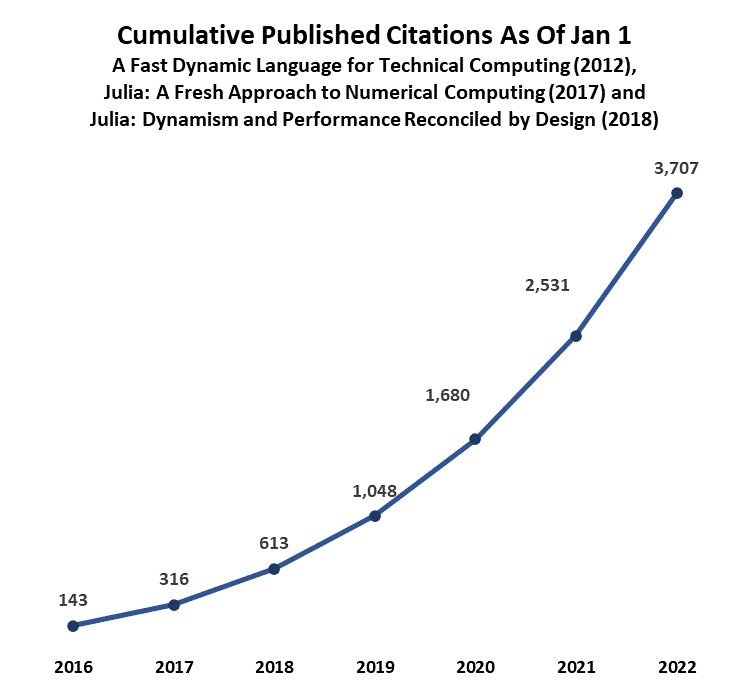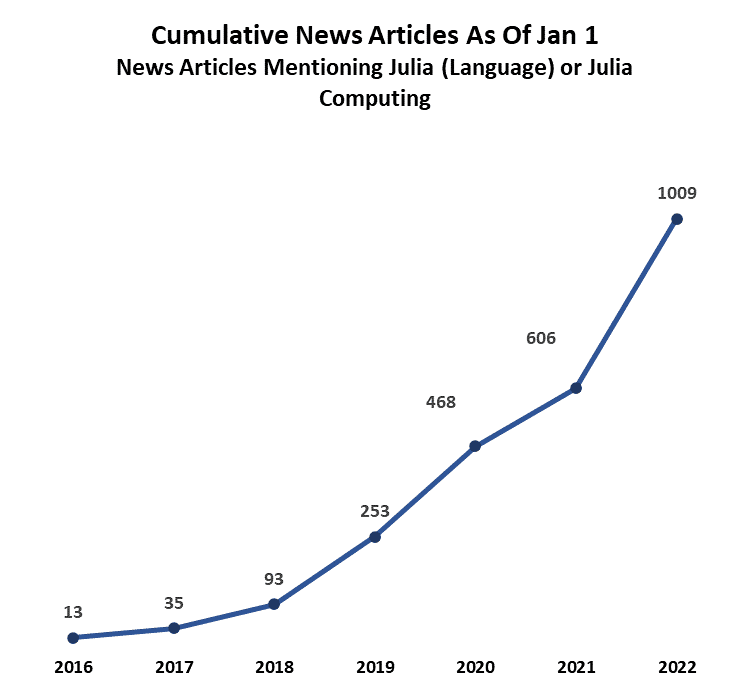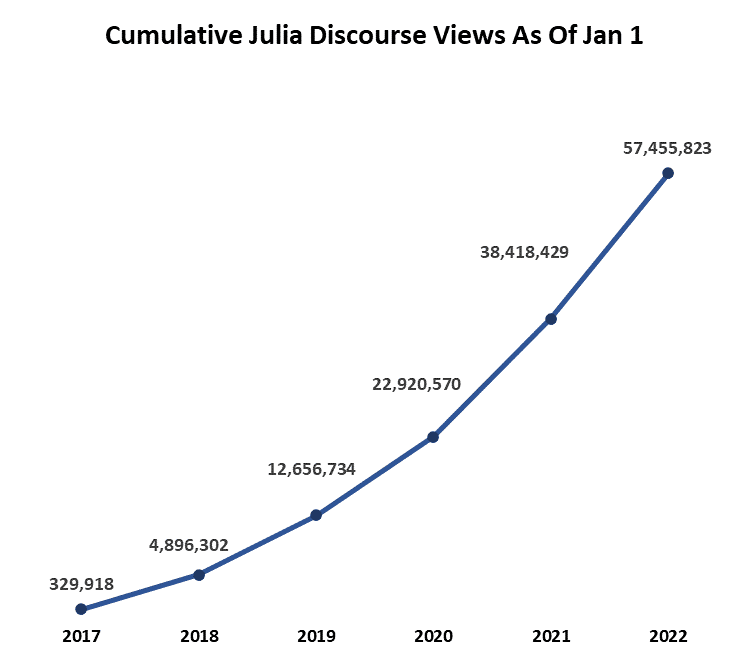Newsletter January 2022 - Julia Growth Statistics
Hey Julia: “Hey Julia, don’t make it bad. Take a slow code and make it better.” Hey Julia is a new song set to the tune of The Beatles’ “Hey Jude”. Click here to watch.

Julia Usage Continues Rapid Growth
1. Downloads: As of Jan 1, 2022, Julia has been downloaded nearly 35 million times - nearly 5x the total cumulative number of downloads as of 3 years ago.

2. GitHub Stars: As of Jan 1, 2022, there are more than 250,000 GitHub stars for Julia + packages, which is more than 13x the total number of GitHub stars as of 6 years ago, and more than 2.5x the total number of GitHub stars as of 2 years ago.

3. Number of Registered Julia Packages: As of Jan 1, 2022, there are 6,896 registered Julia packages - nearly 10x the total number of registered Julia packages as of 6 years ago and nearly 2.5x the total number of registered Julia packages as of 2 years ago.

4. Published Citations: The total cumulative number of published citations of 3 key Julia papers (A Fast Dynamic Language for Technical Computing (2012), Julia: A Fresh Approach to Numerical Computing (2017) and Julia: Dynamism and Performance Reconciled by Design (2018)) is more than 6x what it was 4 years ago and more than 2x what it was 2 years ago.

5. News Articles: As of Jan 1, 2022, there have been 1,009 published news articles that mention Julia (language) or Julia Computing. This is more than 10x the total cumulative number as of 4 years ago and more than 2x the total cumulative number as of 2 years ago.

6. Julia Discourse Views: As of Jan 1, 2022, there have been more than 57 million views on Julia Discourse. That is more than 2.5x the total cumulative number of Julia Discourse views as of 2 years ago, and more than 174x the total cumulative number of Julia Discourse views as of 5 years ago.

7. Julia YouTube Views: As of Jan 1, 2022, Julia videos have been viewed nearly 5 million times - more than 3x the total number of cumulative views as of just 2 years ago.

8. JuliaLang.org Visitors: There have been more than 6.1 million JuliaLang.org visitors as of Jan 1, 2022. This is more than 2x the total cumulative number from just 4 years ago.

Strong Showing for Julia Across HPC Platforms: University of Bristol researchers Wei-Chen Lin and Simon McIntosh-Smith published Comparing Julia to Performance Portable Parallel Programming Models for HPC as part of the International Workshop on Performance Modeling, Benchmarking and Simulation of High Performance Computer Systems (PMBS) from the Institute of Electrical and Electronics Engineers (IEEE). The results are described by The Next Platform in Strong Showing for Julia Across HPC Platforms.
As the authors explain, “Julia is a general-purpose, managed, strongly and dynamically-typed programming language with emphasis on high performance scientific computing. Traditionally, HPC software development uses languages such as C, C++ and Fortran, which compile to unmanaged code. This offers the programmer near bare-metal performance at the expense of safety properties that a managed runtime would otherwise provide. Julia, on the other hand, combines novel programming language design approaches to achieve high levels of productivity without sacrificing performance while using a fully managed runtime. This study provides an evaluation of Julia's suitability for HPC applications from a performance point of view across a diverse range of CPU and GPU platforms. We select representative memory-bandwidth bound and compute bound mini-apps, port them to Julia, and conduct benchmarks across a wide range of current HPC CPUs and GPUs from vendors such as Intel, AMD, NVIDIA, Marvell, and Fujitsu, We then compare and characterise the results against existing parallel programming frameworks such as OpenMP, Kokkos, OpenCL, and first-party frameworks such as CUDA, HIP, and oneAPI SYCL. Finally, we show that Julia's performance either matches the competition or is only a short way behind.”

ASML Uses Julia for Semiconductor Photolithography: ASML is the world’s largest supplier of photolithography systems for the semiconductor industry. Product Architect Matthijs Cox explains: “Another year of #julialanguage at ASML is one more year of blissful programming! We reached over 300 members of ASML Julia enthusiasts this year. And we registered 41 new Julia packages in our internal ASML Julia registry. I love the Julia ecosystem we are building here! This year Julia got formally approved by ASML higher management, so we will keep growing this internal ecosystem further. Creating beautiful Julia packages together with awesome engineers in order to support research and product development across all of ASML's software and data science departments. Finally we can solve the two language problem and bring different engineering competencies together. I don't care if you are a domain expert, data scientist, data engineer, software engineer, software architect, machine learning engineer, business analyst or anything else. If you can code then you can learn Julia and join in on the fun.”
Earthquake Animated Visualization Using Makie.jl: Lázaro Alonso (Max Planck Institute for Biogeoengineering) has published a new animated visualization of the past year’s earthquakes using Makie.jl. Click here to view.

Julia for Neuroscience: UC Berkeley bioengineers Storm Slivkoff and Jack L. Gallant published Design of Complex Neuroscience Experiments Using Mixed-Integer Linear Programming featuring Julia. The authors demonstrate how the experimental design process “can be greatly assisted using an optimization tool known as mixed-integer linear programming (MILP). MILP provides a rich framework for incorporating many types of real-world design constraints into a neuroscience experiment. [Slivkoff and Gallant] introduce the mathematical foundations of MILP, compare MILP to other experimental design techniques, and provide four case studies of how MILP can be used to solve complex experimental design challenges.”
Julia Used to Help 45,500 Needy Families in Brazil: The Brazilian state of Maranhão and Banco do Brasil provided prepaid cards to 45,500 needy families using a card management system written in Julia with GtK. More information is available here from Fabio Sodre, Gestor da Unidade de Gestão da Informação, Secretaria Adjunta da Tecnologia da Informação do Maranhão - SEATI / MA, including this video.

Modeling COVID 19 with Differential Equations: Chris Rackauckas (Julia Computing, Pumas-AI, MIT) joined Quantitative Economics with Julia instructors Jesse Perla (University of British Columbia), Thomas J. Sargent (NYU, Hoover Institution) & John Stachurski (Australian National University) in publishing Modeling COVID 19 with Differential Equations. Click here for more information.

Free Webinar from Julia Computing: Register today to participate in a free one hour Webinar from Julia Computing.
| Webinar | Presenter | Length of Webinar | Date | Time | Registration Link | Cost |
| Building Kubernetes integrated Julia applications with Kuber.jl | Tanmay Mohapatra, Julia Computing | 1 hour | Tue Jan 18 | 12 noon - 1 pm Eastern (US) | Register | Free |
Shopify CEO Tobias Lütke Says Julia Is the “Natural Python Replacement for Machine Learning and Data”: Shopify CEO Tobias Lütke says Julia is the natural replacement for Python for machine learning and data. “It’s amazing how much they unlocked with going all in on multiple dispatch. Also macros are well done (but no comptime).”

New Blog Posts from Logan Kilpatrick, Julia Community Manager: Logan Kilpatrick, Julia Community Manager, has published several new blog posts that may be especially useful for new Julia users or those seeking to persuade others to try Julia out.
-
5 Julia Projects for Beginners — Easy Ideas to Get Started Coding in Julia
-
The Future of Machine Learning and Why It Looks a Lot Like Julia
Learn Julia For Beginners Tutorial: Julia Community Manager Logan Kilpatrick has published a new tutorial, Learn Julia for Beginners - The Future Programming Language of Data Science and Machine Learning Explained on FreeCodeCamp.

Twitter Spaces - The Future of Machine Learning and Why It Looks a Lot Like Julia: Julia Community Manager Logan Kilpatrick presented The Future of Machine Learning and Why It Looks a Lot Like Julia via Twitter Spaces. Click here to listen.
Julia for Pythonistas: Aurélien Geron has published a Google Colab / Jupyter notebook introduction to Julia for Python programmers. Click here for more.
Automated Code Optimization with E-Graphs: Alessandro Cheli (University of Pisa) and Christopher Rackauckas (Julia Computing, Pumas-AI, MIT) have published Automated Code Optimization with E-Graphs. The authors “propose an advanced, generic and high-level code rewriting and analysis system in the Julia programming language, providing applied equality saturation in the presence of multiple dispatch and metaprogramming. We show how our system can practically solve some challenging problems: Can programmers implement their own high-level compiler optimizations for their domain-specific scientific programs, without the requirement of them being compiler experts at all? Can these optimizers be implemented by users in the same language and inside the same programs they want to optimize, solving the two-language problem? Can these compiler optimizers be written in a high-level fashion, as equations, without the need to worry about the rewriting ordering? Thus, can symbolic mathematics do high-level compiler optimizations or vice-versa?”

JuliaClimate Notebooks: The JuliaClimate community has shared JuliaClimate notebooks that demonstrate JuliaClimate packages working in concert. Click here for more.

Careers at Julia Computing: Julia Computing is a fast-growing tech company with fully remote employees in 11 countries on 4 continents. Click the links below to learn more about exciting careers and internships with Julia Computing.
Please click here for more information and to apply.
Pumas - Enhanced and In the Cloud: Pumas-AI has launched an enhanced version of Pumas that is readily accessible in the cloud. Pumas is the revolutionary advanced healthcare analytics platform that facilitates quantitative capabilities across the drug development cycle. Designed from the ground up in Julia, Pumas allows users to scale, integrate and accelerate their quantitative scientific activities all under one umbrella. Pumas is a product of Pumas-AI and deployed through the JuliaHub platform from Julia Computing to leverage JuliaHub's ease of use and scalability. Julia Computing is a technology partner and exclusive reseller of Pumas. Click here for more information.

JuliaHub from Julia Computing: JuliaHub is the entry point for all things Julia: explore the ecosystem, build packages and deploy a supercomputer at the click of a button. JuliaHub also allows you to develop Julia applications interactively using a browser-based IDE or by using the Pluto notebook environment and then scale workloads to thousands of cores. Version 5 features a brand new user interface, reduced app startup latency, and many more usability enhancements. JuliaHub is the easiest way to start developing in Julia or share your work using dashboards and notebooks.
More information is available in these two presentations from Dr. Matt Bauman (Julia Computing):

Dyad (Formerly JuliaSim): Dyad is a next generation cloud-based modeling and simulation platform, combining the latest techniques from scientific machine learning with equation-based digital twin modeling and simulation. More information about Dyad (Formerly JuliaSim) is available in this presentation from Dr. Chris Rackauckas.

Converting from Proprietary Software to Julia: Are you looking to leverage Julia’s superior speed and ease of use, but limited due to legacy software and code? Julia Computing and our partners can help accelerate replacing your existing proprietary applications, improve performance, reduce development time, augment or replace existing systems and provide an extended trusted team to deliver Julia solutions. Leverage experienced resources from Julia Computing and our partners to get your team up and running quickly. For more information, please contact us.
Julia and Julia Computing in the News
-
The Next Platform: Strong Showing for Julia Across HPC Platforms
-
Analytics Insight: Top 10 Programming Languages that Data Scientists Should Learn in 2022
-
Analytics Insight: 10 Programming Languages to Deal with Small Data in 2022
-
Analytics Insight: Top 10 Open-Source AI Tools and Frameworks to Use in 2022
-
HPC Wire: SC21 Panel on Programming Models – Tackling Data Movement, DSLs, More
-
Seeking Alpha: Genomic Medicine 2021: (Happy To) Turn The Page
-
Your Story: Best of 2021: Conversations on Building & Finding Opportunities
-
Your Story: From Strategy to Skills - 65 Quotes on the Importance and Impact of Design
-
Appinventiv: A Complete Guide on Data Science & Analytics for Businesses
-
Cyprus Mail: Machine Learning Challenge for University Students
Julia Blog Posts
-
Advent of Code 2021 - Day 1-25 (Eric Burden)
-
Nbdev.jl and Literate Programming (Satyabrata Pal)
-
6 Julia Frameworks to Create Desktop GUI’s and Web Apps (Logan Kilpatrick)
-
5 Julia Projects for Beginners — Easy Ideas to Get Started Coding in Julia (Logan Kilpatrick)
-
The Future of Machine Learning and Why It Looks a Lot Like Julia (Logan Kilpatrick)
-
Julia Data Modeling: A Pointy Example (Matthijs Cox)
-
Fitting Mixed Effects Models - Python, Julia or R? (Dean Markwick)
-
New Features in DataFrames.jl 1.3: Part 2 (Bogumił Kamiński)
-
New Features in DataFrames.jl 1.3: Part 3 (Bogumił Kamiński)
-
New Features in DataFrames.jl 1.3: Part 4 (Bogumił Kamiński)
-
New Features in DataFrames.jl 1.3: Conclusion (Bogumił Kamiński)
-
Engineering Trade-Offs in Automatic Differentiation: from TensorFlow and PyTorch to Jax and Julia (Chris Rackauckas)
-
Multi-Columns, Shortcut Strings and Subset Transformations in DataFrameMacros.jl v0.2 (Julius Krumbiegel)
-
Using DataFrames and PyPlot in Julia (Jaafar Ballout)
-
Introduction to Julia (Jaafar Ballout)
-
Optimization with JuMP in Julia (Jaafar Ballout)
-
Linear Programming in Julia with GLPK and JuMP (Jaafar Ballout)
-
10 Things I Love About Julia (Trang Le)
-
Everything You Need to Know About Indexing in Julia (Emmett Boudreau)
-
Exploring The Nuances Of Documentation in Julia (Emmett Boudreau)
-
Everything You Need to Know about Push! in Julia (Emmett Boudreau)
-
Julia’s Doc-String System Is Awesome, And Here Is Why (Emmett Boudreau)
-
What On Earth Is An Anonymous Function? (Emmett Boudreau)
-
5 Awesome Things To Love About The Julia Language (Emmett Boudreau)
-
How Mutability Works In Julia (Emmett Boudreau)
-
Creating A Pluto.jl Notebook Reader In Julia (Emmett Boudreau)
-
Building A Server Settings Configuration For My Notebook Server (Emmett Boudreau)
-
Building a Cell Data Format For My Custom Notebook Server (Emmett Boudreau)
-
Introducing Jockey.jl — A Pretty Rad New Notebook Editor (Emmett Boudreau)
-
A Swift Introduction To VegaLite.jl — StatPlots For Julia (Emmett Boudreau)
-
Julia Is Not Hard! (Emmett Boudreau)
-
5 Spectacular Features From Julia I Wish Were In Python (Emmett Boudreau)
-
Destroying Every Programming Concept You Know With Julia (Emmett Boudreau)
Upcoming Julia Events
-
Virtual Meetup: Coffee Meeting (Online) with Julia Gender Inclusive Jan 16
-
Webinar: Building Kubernetes Integrated Julia Applications with Kuber.jl with Tanmay Mohapatra (Julia Computing) Jan 18
-
Virtual Meetup: Julia Meetup: Makie.jl with Boulder Data Science, Machine Learning and AI Jan 20
-
Virtual Meetup: Coffee Meeting (Online) with Julia Gender Inclusive Feb 27
-
Virtual Meetup: Coffee Meeting (Online) with Julia Gender Inclusive Apr 12
-
Virtual Meetup: Coffee Meeting (Online) with Julia Gender Inclusive May 29
Recent Julia Online Events
-
Virtual Meetup: Julia Meetup with Boulder Data Science, Machine Learning and AI Dec 16
-
Virtual Meetup: The Future of Machine Learning and Why It Looks A Lot Like Julia with Logan Kilpatrick via Twitter Spaces Jan 10
Contact Us: Please contact us if you wish to:
-
Purchase or obtain license information for products such as JuliaHub, Dyad (Formerly JuliaSim) or Pumas
-
Obtain pricing for Julia consulting projects for your organization
-
Schedule online Julia training for your organization
-
Share information about exciting new Julia case studies or use cases
-
Spread the word about an upcoming online event involving Julia
-
Partner with Julia Computing to organize a Julia event online
-
Submit a Julia internship, fellowship or job posting
About Julia Computing and Julia
Julia Computing's mission is to develop products that bring Julia's superpowers to its customers. Julia Computing's flagship product is JuliaHub, a secure, software-as-a-service platform for developing Julia programs, deploying them, and scaling to thousands of nodes. It provides the power of a supercomputer at the fingertips of every data scientist and engineer. In addition to data science workflows, JuliaHub also provides access to cutting-edge products such as Pumas for pharmaceutical modeling and simulation, Dyad (Formerly JuliaSim) for multi-physics modeling and simulation, and Cedar for electronic circuit simulation, combining traditional simulation with modern SciML approaches.
Julia is the fastest high performance open source computing language for data, analytics, algorithmic trading, machine learning, artificial intelligence, and other scientific and numeric computing applications. Julia solves the two language problem by combining the ease of use of Python and R with the speed of C++. Julia provides parallel computing capabilities out of the box and unlimited scalability with minimal effort. Julia has been downloaded by users at more than 10,000 companies and is used at more than 1,500 universities. Julia co-creators are the winners of the 2019 James H. Wilkinson Prize for Numerical Software and the 2019 Sidney Fernbach Award. Julia has run at petascale on 650,000 cores with 1.3 million threads to analyze over 56 terabytes of data using Cori, one of the ten largest and most powerful supercomputers in the world.
About the Author

JuliaHub
Discover key content authored by JuliaHub experts. Stay updated on innovative practices in scientific and technical computing.


